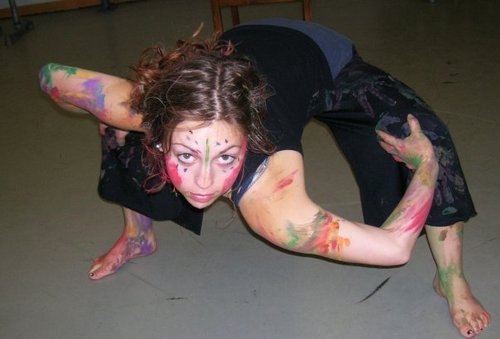Enjoy what our teacher Hannah has to say about the seamless mixture of art and yoga:
The Ritual of Art and Yoga by Hannah Skye Wenzel

Acting school is a uniquely bizarre experience – especially when you go to acting school in Ithaca, New York, a hippie haven surrounded by waterfalls, vineyards, and (for most of the year) piles and piles of ice and snow. Normal college students complete homework in a library with laptops rather than in a studio with body paint, doing things that often involve nudity, or heavy emotional release. My college education was four glorious years of nettie pots, mask making, dance leotards, and practicing things like the Bartenieff fundamentals, bio-energetics, rasa-boxes, and Grotowski’s Cat. (If you want to learn about something weird/awesome, look up any of those things.)
I’m not really an actor any more – I’m a yoga teacher. But I probably wouldn’t be a yogini if I hadn’t spent four years in upstate New York laying bare my soul and turning my body into a story-telling instrument. We moved, we stretched, we sang – we did a lot of happy babies, sun salutations, and something called Kundalini shaking.
What does any of this have to do with yoga? Hang tight, I’m getting there.
Because even years later, there is one assignment in particular I find myself thinking back on with regularity.
The class was called “Styles of Acting.” It was exactly what it sounds like. We learned different styles of acting from different time periods and different cultures, beginning with Greek theater. Greek theater hinges around the idea of ritual. Our assignment was to create and perform a ritual in front of the class.
The ritual had to include elements of ceremony, but most importantly, the ritual had to result in some form of change. This presented somewhat of a problem. Everyone developed an idea for a ritual, a costume, usually some made up language (that was part of the assignment as well, no real words) sometimes dancing…but unless something physical was obviously and tangibly different by the end, the ritual was a failure and received a corresponding grade.
I should say that this assignment was somewhat of a right of passage and there were some famous…or rather infamous rituals that happened during my time at school. One student ran around the theater lighting feather pillows on fire while chanting, “AH BELLY BOOMSADAY!” (I don’t know what his ritual was about.)
Since actors aren’t usually shy, there was always quite a lot of nudity…A friend of mine created her “change” by smashing bottles of alcohol in the nude to symbolize the end of substance abuse. She was rushed to the health center with bleeding hands and feet from all the broken glass.
My performance was less sensational, but earned me an A, regardless. I spent a full evening catching white moths from around a porch light and brought them to class with me, trapped in tiny cups and jars. I ceremoniously freed them all into the theater, symbolically exorcising unhappy ghosts/thoughts/energy.
Ritual. Change. Magic. When you watch a movie or see a play, you are watching a ritual acted out. It’s not real – but something happens in the world of the performance. It’s not an imaginary happening, it’s quite tangible, even if it’s not literal. And if it’s a good performance, the audience member too, is changed.
Change.
That’s what a good yoga practice is, too.
You arrive on your mat in a certain physical, mental, emotional and energetic state. Something happens.
You move, you breath.
Something changes.
Sometimes the change is purely physical, sometimes it’s exclusively internal, and most of the time it’s both. Sometimes the change is dramatic. Sometimes it’s subtle. But consciously or not, we all seek some form of change.
Take the time when you arrive on your mat, to understand what that change represents to you.
And finally, understand that though the ritual is a vehicle through which we navigate our change, no performance, no yoga practice is ever exactly the same, nor is it ever flawless.
Because change cannot be forced.
Change can only be invited – and practiced.

No comments
Post a Comment